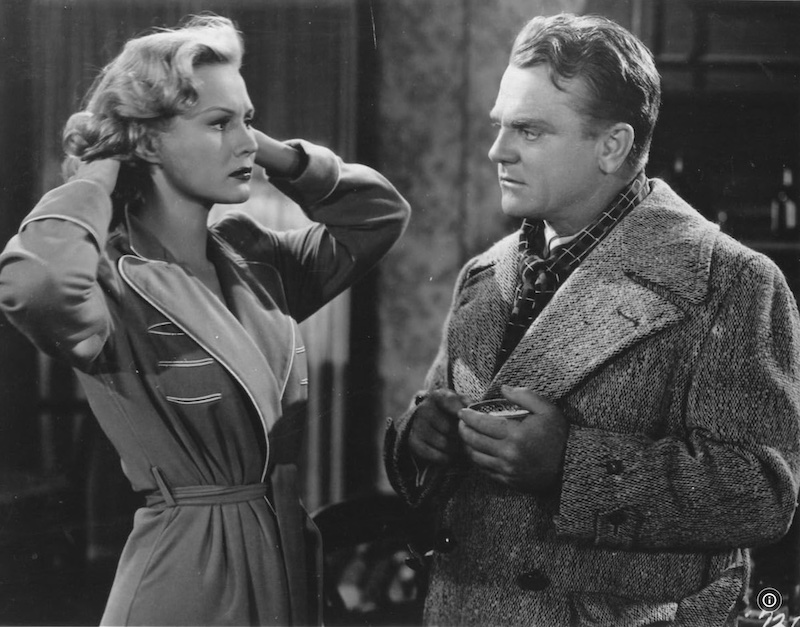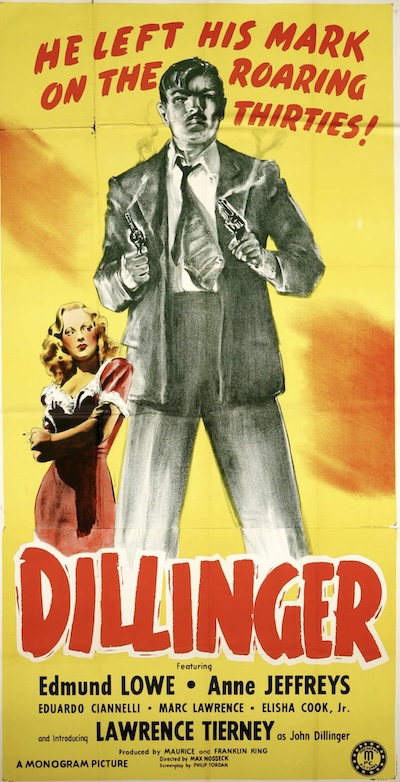Saturday September 16, 2023
Movie Review: Dillinger (1945)

WARNING: SPOILERS
The 1945 movie “Dillinger” may have more in common with the 1949 James Cagney movie “White Heat” than it does with John Dillinger.
In this way.
In the beginning of the third act, an attempted train robbery goes awry, gang leader John Dillinger (Lawrence Tiereney) is wounded, and the gang holes up in a mountain cabin, where the protagonist's blonde dame (Anne Jeffreys) gets too chummy with one of the gang members. Sound familiar? You could segue that right into the beginning of “White Heat,” where an attempted train robbery goes awry, a gang member is wounded, and the gang holes up in a mountain cabin where the protagonist's blonde dame (Virgina Mayo) gets too chummy with one of the gang members. Basically “White Heat” begins near where “Dillinger” ends.
Jeffreys and Mayo even look alike:


“White Heat” is the better movie, of course, and it has Cagney. The amazing thing about Cagney is that even when he played an awful person you still liked him. You felt for him. Not true for Tierney. He plays Dillinger as a flaming asshole and you get the feeling it’s not just Dillinger.
And introducing…
This is the movie debut of Tierney, who would become famous in my day as the gruff, bald bossman in “Reservoir Dogs.” Here, he’s young and slim with slicked-back hair. He’s got a B-grade Kirk Douglas thing going. In the opening credits, he’s “And introducing…”
This was Hollywood’s introduction to Dillinger, too. He was gunned down outside the Biograph Theater in Chicago in July 1934, but that was about the time the Production Code grew teeth. Since Catholic orgs were already up in arms (so to speak) about fictional gangsters like Tom Powers and Tony Camonte, one assumes the studios decided to steer clear of the real deal. Elements of Dillinger’s story may have been used in 1935’s “Public Hero No. 1” starring Chester Morris, but that character was named Jeff Crane. Here it’s finally John Dillinger.
Of course, how much of it is John Dillinger? Iffy.
The movie begins where Dillinger’s life ended: at a movie theater. After a quick “News of the World”-type documentary on the bank robber, Dillinger’s dad comes onstage, hat literally in hand, to talk about his son. He says young John was like the other boys until he wasn’t. “It was best to give him his head,” Dad says.

Then we cut to Dillinger as a grown man about to commit his first crime. This is part of the film that feels iffy. He’s at a bar/diner with a blonde, the waiter won’t take his check, so he goes into the night and knocks off a little grocer. Gets $7.20. Then he runs straight into a cop and straight into prison. There he talks big but is surrounded by guys who actually knocked off banks—primarily his cellmate Specs (Edmund Lowe), who leads a gang of three: Marco (Eduardo Ciannelli), Doc (Marc Lawerence), and Kirk (Elisha Cook Jr.). Kirk has a grape-eating habit that I assumed would come into play but doesn’t.
The other gang members don’t think much of the loudmouthed kid but Specs figures he’ll be useful. And he is: paroled first, he springs the others with a scheme involving firearms smuggled into cement-mix barrels. Afterwards, they’re knocking off bank after bank, with Specs leading the way and Dillinger marginalized and seething on the sidelines. Then he comes up with a great scheme and suddenly the gang is his. It’s a quick turnabout.
As they cut a swath west, the movie suggests Dillinger is captured at a dentist in Tucscon, Ariz., because Specs squeals to the cops. Then we get part of the legend I remember: Dillinger, in prison, carving a gun out of a piece of wood, painting it with shoe polish, and escaping. (I flashed on the Woody Allen twist in “Take the Money and Run” and laughed.) Back at the hideout, Dillinger kills Specs for squawking and takes over the gang for good. His next scheme is the aforementioned train robbery, which will sic the feds on them, and get Kirk killed and Dillinger wounded. Their mountain hideaway belongs to Kirk’s surrogate parents, so there’s tension, but I like how economical the movie is about it. Nobody says anything. The elders just seeing the gang tromping in without Kirk and get it. After an attempted late-night call to the cops, Dillinger kills them.
Again, this section is very “White Heat.” Dillinger’s dame, Helen Rogers, a movie theater cashier he robbed, winds up spending time with Tony (Ralph Lewis), the newest, youngest and cutest member of the outfit, and Dillinger doesn’t like it. It’s not just paranoia, either—they have something going. So Tony gets an off-screen axe in the back, the last of the gang surrenders to the feds, and Dillinger and Helen flee to Chicago, where Dillinger holes up in a two-bit hotel, while Helen keeps eyeing the $15K reward for his capture. It’s December, and, trapped, he listens to a street-corner Santa (in creepy mask) and kids singing Christmas carols. For a moment, I worried they were going to off him in December rather than July.
Nope. We cut ahead seven months, when Dillinger, now sporting a bad moustache and small sunglasses—like in life—takes Helen to the Biograph for “Manhattan Melodrama,” a gangster flick starring Clark Gable, as the feds close in. Helen dresses in red. She’s both Billie Frechette (his lover) and Anna Sage (the woman in red who betrayed him).
$7.20
Is Dillinger most famous for how he left us? I still wonder why him. How did he become as big a story as he became. If you do a newspapers.com search on “John Dillinger,” he was nothing until 1934, when he was everything; then he was nothing again.
Number of mentions of “John Dillinger” in U.S. newspapers:
- 1932: 58
- 1933: 3,527
- 1934: 81,994
- 1940: 1,044
- 1944: 792
Yet the name lives on. We didn’t get another cinematic Dillinger until Leo Gordon played him in Don Siegel’s “Baby Face Nelson” in 1957, and not another attempted biopic until 1965’s “Young Dillinger,” starring Nick Adams. Post-“Bonnie and Clyde,” everyone tried: the Italians (“Dillinger is Dead,” 1969), John Milius (“Dillinger,” 1973, starring Warren Oates), Roger Corman (“The Lady in Red,” 1979, written by John Sayles, focusing on Frechette). Eventually we got around to Michael Mann and his mania for detail in 2009.
1945’s “Dilllinger” was directed by Max Nosseck, a German-Jewish director who fled Nazi Germany in 1933 and wound up directing nothing big. This one, at 6.5, is his fourth-ranked on IMDb. I’d be interested in seeing his top-ranked, “Singing in the Dark” at 7.4. It’s from 1956, about a Holocaust survivor. Tierney has a small part.
The shock for Hollywood in 1945 was less that “Dillinger” was made than it garnered an Academy Award nomination for Philip Yordan for best original screenplay—but that shouldn’t have been a shock. In the early days, gangster flicks often got screenplay and story noms. In one ceremony alone, three of the five story nominations were gangsters: “Doorway to Hell,” “Smart Money” and “The Public Enemy.” The previous go-round, Ben Hecht’s “Underworld” won, and a few years later, Arthur Caesar’s “Manhattan Melodrama”—the movie that killed Dillinger—won. It was a theme.
Virginia Kellogg got nom’ed for story for “White Heat,” too, but I am curious if she saw this. Her story was supposedly based on Ma Barker and his boys, then it evolved into Ma and one boy, while Cagney suggested getting psychopathic and psychological with it.
In the end, for all the problems regal Hollywood had with a two-bit outfit like Monogram Pictures glorifying an infamous bank robber like John Dillinger, “Dillinger” winds up being that rare biopic where you don’t care much for the main subject. He starts out a jerk, he ends a jerk. After he’s shot down outside the Biograph, the cops go through his pockets and find $7.20—the same as after his initial robbery. That’s what crime will get you, kids: nothing. Remember that.
Baseball's Active Leaders, 2023
What Trump Said When About COVID
Recent Reviews
Everything Everywhere All at Once (2022)
Black Panther: Wakanda Forever (2022)
Doctor Strange in the Multiverse of Madness (2022)
Spider-Man: No Way Home (2021)
The Cagneys
A Midsummer Night's Dream (1935)
Something to Sing About (1937)
Angels with Dirty Faces (1938)
A Lion Is In the Streets (1953)
Man of a Thousand Faces (1957)
Never Steal Anything Small (1959)
Shake Hands With the Devil (1959)







